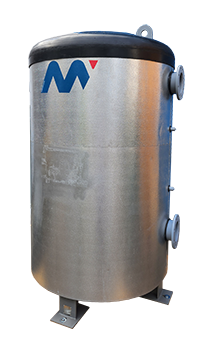A buffer tank is often incorporated into a chilled water or heating water system that has insufficient water volume throughout the piping network in relation to the chiller or boiler capacity.
Features
These tanks are insulated so that the stored water maintains its chilled temperature. This allows the tank to charge up during off-peak periods, thus reducing the chiller’s workload during peak periods throughout the next day.
We usually supply these with a relief valve.
By adding a buffer tank, extra volume is created to provide “buffer” capacity and eliminate problems like:
- Excessive compressor cycling
- Poor temperature control
- Erratic system operation
In some instances, when a large building is undergoing refurbishments or extensions, the capital expenditure of a large chiller can be deferred by installing large buffer tanks and utilising the existing chiller.
Mild steel and stainless steel buffer tanks are completely customisable in terms of dimensions, insulation R values, and internal configurations for baffle plates and/or sparge pipes.
The standard Aquazone range, available as bare tanks or preinsulated & cladded:
-
- C0 series for chilled water up to 15 degrees Celsius & multiple connections, 300-10,000L
- H0 series for heating water up to 65 degrees Celsius & multiple connections, 300-10,000L
- C1 series for chilled water up to 15 degrees Celsius & internal baffle for promoting serpentine flow, 300-5,000L
vH1 series for heating water up to 65 degrees Celsius & internal baffle for promoting serpentine flow, 300-5,000L
- CD series to fit though a standard doorway, available as bare tanks only, up to 1500L capacity
Frequently asked Questions
- What hazard level does my tank need to meet?
AS1210 page 21 clause 1.8.12 calls up AS4343 as the code for determining pressure vessel hazard levels. According to this, your tank must meet Hazard Level E.
- Do I need a vacuum breaker?
A vacuum breaker valve is commonly used on top of a buffer tank, but rarely in the HVAC industry. They are used as a safety measurement when draining the tank, which is when a vacuum may occur. They are commonly placed in the system pipeline as opposed to the tank. They are mostly used on petrol tanks.
- What is ozone depletion on buffer tank insulation?
Ozone depleting substances (ODS) are a list of materials (gasses mostly) that are proven to destroy thew ozone layer. The rate at which they do so varies per substance and are therefore more or less prohibited. In the insulation industry, ODS could be used as foaming agents in production, which can stay trapped in the material and leach out over time. Current regulations prohibit the use of the ODS material more and more, requiring MSDS and TDS documents to prove it. You can be assured all the products we use comply with all Australian Standards for this and this is shown on the TDS documents.
Relevant Resources for Aquazone Buffer Tanks
GET BETTER PERFORMANCE WITH MASTERFLOW’S RANGE OF Aquazone Buffer Tanks
Over the decades, we’ve built ourselves on our ability to provide innovative engineering solutions that work. We pride ourselves on long-term client relationships due to exceptional service. Contact us today to see how we can support you on your next project.

